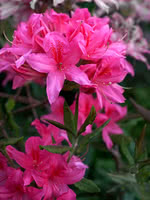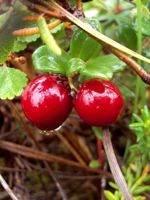Mon-Fri 9am - 5pm Mountain time
Rosy Lights Rhododendron (Azalea) vs Small Cranberry
Rhododendron x Rosy Lights
Vaccinium oxycoccos
CUSTOM GROW
CUSTOM GROW
Rosy Lights Rhododendron is the next flowering, deciduous shrub you need in your garden. It is incredibly cold hardy and produces fragrant, bright pink blooms in late spring. Pruning is recommended after the flowers are finished to control the size and shape of this shrub.
Try Rosy Lights Rhododendron when planning your next hedge/screen, or plant it on its own as a striking accent plant. Part of the Northern Lights Series.
Small Cranberry is a native evergreen groundcover found in bogs, fens, and wet meadows. It produces delicate pink flowers that attract a variety of pollinators, including bees, and it serves as both a nectar source and host plant for the Bog Fritillary (Boloria eunomia) butterfly. By late summer, the plant bears deep red berries that are eaten by both wildlife and people. With their high pectin content, the berries are well-suited for making jams and jellies.
Often creeping among sphagnum moss, Small Cranberry thrives in cold, acidic, and nutrient-poor soils (pH 2.9–4.7), making it well adapted to northern wetland environments. With its woody stems, it is technically classified as a shrub and often described as a subshrub or dwarf shrub. It is also valuable for wetland restoration and naturalisation projects.
Note: We use Small Cranberry for Vaccinium oxycoccos. This species is also known by many other common names, including Bog Cranberry, Small Bog Cranberry, and others. Please confirm the scientific name to ensure you are ordering the correct plant.
Rosy Lights Rhododendron (Azalea) Quick Facts
Small Cranberry Quick Facts
Toxicity: All parts of a rhododendron bush, including the leaves, stems and blooms, are toxic to cats, dogs, and horses.

